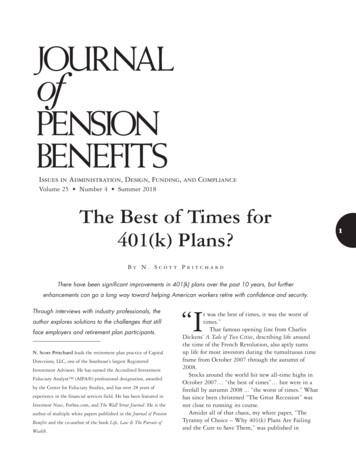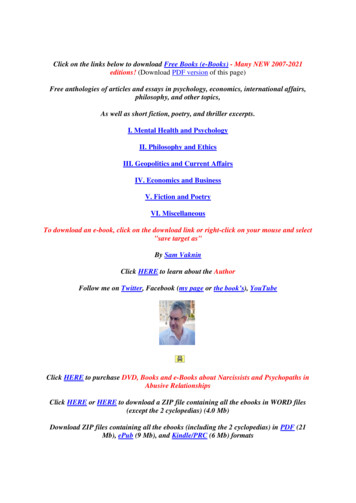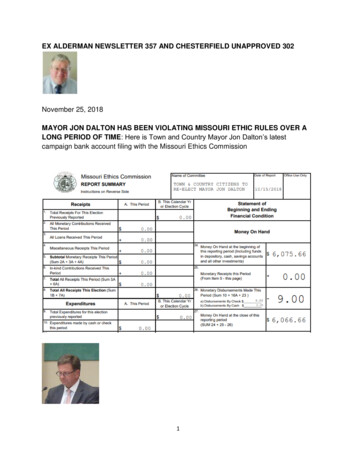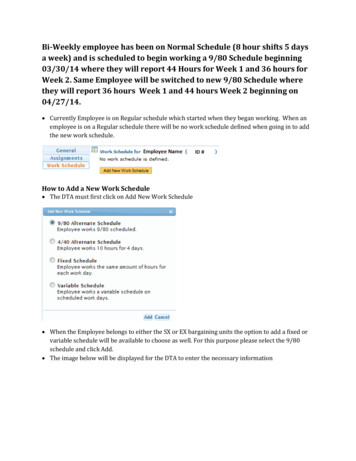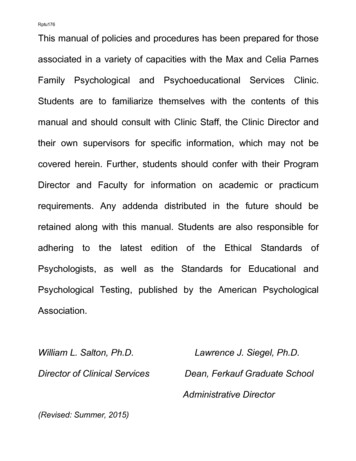
Transcription
Ericksonʼs two major contributions are his utilization principle and hisprecise use of vague language.With this information-packed book,theauthors succeed in setting readers squarely on the path to utilizing vaguelanguage precisely!We highly recommend Ericksonian Approaches toanyone interested in learning and integrating these powerful methodsinto his or her practice.C.Alexander Simpkins Ph.D.and Annellen M.Simpkins PhD San Diego,CAThe developing new maturity of a new school of professionalpsychotherapy is signaled by the appearance of Comprehensive Manualsthat attempt to integrate the best inspirations of the pioneers withthe growing body of fundamentals that are needed to teach anothergeneration. This comprehensive manual by Thomas South and RubinBattino and their colleagues takes on this task with honesty and integrity.Ernest L. Rossi, PhDDavid Slater, Hypnotherapy AssociationThomas L. South has a PhD in clinicalpsychology and has taught courses inEricksonian hypnotherapy at the Universityof Dayton and at Wright State University.He is the founder and first president ofthe Milton H. Erickson Society of Dayton,Ohio.ErickApproach FP 0906.indd 1ISBN Crown House Publishing Limitedwww.crownhouse.co.ukJacket design byMilton H. Erickson Society of Dayton9 7 81 904 42 491 8Rubin Battino, MS &Thomas L. South, PhDThe second edition is certainly worthy of purchase (even if you alreadyhave the first). The editions and revisions make what I considered to bean already excellent book, even better.EricksonianApproachesA Comprehensive ManualSecond EditionSecond EditionRubin Battino, MS has a private practicein Yellow Springs, Ohio. He providestraining in Ericksonian hypnosis andpsychotherapy, and is an AdjunctProfessor in the Department of HumanServices (counseling) at Wright StateUniversity. He is President of the MiltonH. Erickson Society of Dayton, Ohio andwas co-chair of a committee to establishcertification standards for training inEricksonian hypnotherapy for the societiesand institutes affiliated with the Milton H.Erickson Foundation. He is the author ofGuided Imagery and Other Approachesto Healing, Coping: A Practical Guidefor People with Life-Challenging Diseasesand their Caregivers, Meaning: A PlayBased on the Life of Viktor E. Frankl,and Metaphoria: Metaphor and GuidedMetaphor for Psychotherapy and Healing.Ericksonian ApproachesJeffrey K. Zeig, PhD, Director, The Milton H. Erickson FoundationA Comprehensive ManualStudents delight! Fundamentals of the Ericksonian approach have neverbeen so easy to learn. Tom South and Rubin Battino offer an eminentlycomprehensible training manual abounding with illustrations andexercises.Rubin Battino, MS andThomas L. South, PhDForeword by Ernest Rossi, PhDForeword to the Second Edition byRoxanna Erickson Klein, PhD, RN andBetty Alice Erickson, MSMany books have been written byand about Milton H. Erickson andhis unique contribution to the field ofhypnotherapy. Very few are designedas training resources in Ericksonianhypnotherapy. None of them providethe comprehensive training programthat is Ericksonian Approaches.The definitive training manual in theart of Ericksonian hypnotherapy,this easily accessible book providesa systematic approach to learningthe subject, set against a clinicalbackground. A thoroughly practicalresource that assumes no previousknowledge of the field, it develops thesubject over twenty-three chapters thatinclude: the history of hypnosis myths and misconceptions traditional vs non-traditionalinductions rapport-building skills language forms basic and advanced inductions hypnotherapy without trance utilization of ideodynamic responses basic and advanced metaphor Ericksonian approaches in medicine,dentistry, substance abuse and lifechallenging diseases ethical and legal considerations.This revised and updated edition alsoincludes new chapters on: Metaphor Therapy and GuidedMetaphor Ernest Rossiʼs work on thepsychobiology of gene expression26/9/06 9:28:23 am
Prelims.qxd12/05/200510:27Page AEricksonianApproachesA Comprehensive ManualSecond EditionRubin Battino, MSWright State UniversityandThomas L. South, PhDTwin Valley Psychiatric System Dayton CampusChapters by:James Auld, BDS, Dip Soc Sc, MScLeon S. Segal, MASandra Sylvester, PhDMS, Mental Health CounselingAdjunct Professor, Department of Human Services (Counseling)Wright State UniversityCrown House Publishing Limitedwww.crownhouse.co.uk
Prelims.qxd12/05/200510:27Page BFirst published byCrown House Publishing LtdCrown Buildings, Bancyfelin, Carmarthen, Wales, SA33 5ND, UKwww.crownhouse.co.ukandCrown House Publishing Company LLC4 Berkeley Street, 1st Floor, Norwalk, CT 06850, USAwww.CHPUS.com 1999, 2005, Rubin Battino & Thomas L. SouthFirst edition published in 1999 and reprinted in 2000, 2001, 2002 and 2004 (twice) (OriginalISBN: 1899836314; original LCCN: 2002109964).The right of Rubin Battino & Thomas L. South to be identified as the authors of this workhas been asserted by them in accordance with the Copyright, Designs and Patents Act 1988.Permissions to quote from the following sources are gratefully acknowledged:Zeig, G.K. (1980). A teaching seminar. pp. 99–100. Bristol, PA: Taylor & Francis(Brunner/Mazel). American Journal of Clinical Hypnosis: 1, 117–21 (1959); 2, 227–31 (1960); 3,112–16 (1960); 7, 64–70 (1964); 7, 152–62 (1964); 8, 57–65 (1965); 8, 198–209 (1966); 15,217–22 (1973); 20, 20–35 (1977). Haley, J. (1985). Conversations with Milton H. Erickson. LaJolla, CA: Triangle Press; Vol. I p. 59, Vol. I pp. 81–2, Vol. I pp. 118–19, Vol. I pp. 258–9,Vol. II pp. 123–6, Vol. III pp. 12–14, Vol. III pp. 135–8. Cheek, D.B. and LeCron, L. (1968).Clinical hypnotherapy. Philadelphia: Gruen and Stratton (W.B. Saunders Co.). Gordon, D.and Meyers–Anderson, M. (1981). Phoenix. Capitola, CA: Meta Publications; pp. 67–9,pp. 131–2, pp. 139–40. Cooper, L. and Erickson, M.H. (1959). Time distortion in hypnosis.Baltimore: Williams and Wilkins (A Waverly Company); “guitar practice,” (courtesy ofDr. Linn F. Cooper). Erickson, M.H. and Rossi, E.L. (1981). Experiencing hypnosis. pp. 15–16,155–68 (selected portions); Erickson, M.H. and Rossi, E.L. (1979). Hypnotherapy: Anexploratory casebook. pp. 77–8. New York: Irvington Publishers, Inc.The following are all reprinted by permission of W.W. Norton & Company, Inc. From Myvoice will go with you: the teaching tales of Milton H. Erickson by Sidney Rosen; excerpts frompp. vii, viii, ix, 36–7, 151–2. Copyright 1982 by Sidney Rosen, M.D. From UncommonTherapy: the psychiatric techniques of Milton H. Erickson, M.D. by Jay Haley. Copyright 1986 by Jay Haley; excerpts from pp. 157, 239, 280–2. From Mind–body therapy: ideodynamichealing in hypnosis by Ernest Lawrence Rossi and David B. Cheek. Copyright 1988 byErnest L. Rossi and David B. Cheek; excerpts from pp. 182–3, 187–8, 217–8, 295–6. FromThe psychobiology of mind–body healing, revised edition by Ernest Lawrence Rossi. Copyright 1993 by Ernest Lawrence Rossi; excerpts from p. 39. From An uncommon casebook: thecomplete clinical work of Milton H. Erickson, M.D. by William Hudson O’Hanlon and AngelaL. Hexum, eds. Copyright 1990 by William Hudson O’Hanlon and Angela L. Hexum;excerpts from pp. 101, 104.All rights reserved. Except as permitted under current legislation no part of this work maybe photocopied, stored in a retrieval system, published, performed in public, adapted,broadcast, transmitted, recorded or reproduced in any form or by any means, without theprior permission of the copyright owners. Enquiries should be addressed to Crown HousePublishing Limited.British Library of Cataloguing-in-Publication DataA catalogue entry for this book is available from the British Library.10-digit ISBN 190442491013-digit ISBN 978-190442491-8LCCN 2005924700Printed and bound in the UK byCromwell Press, Trowbridge, Wiltshire
Prelims.qxd12/05/200510:27Page iTable of ContentsPrefacePreface to the Second EditionForewordForeword to the Second EditionContributorsviiixxixvxixChapter 1History of Hypnosis: Thomas L. SouthA. IntroductionB. Franz Anton Mesmer (1734–1815)C. John Elliotson (1791–1868)D. James Esdaille (1808–1859)E. James Braid (1795–1860)F. Milton H. Erickson (1901–1980)Exercises11257111618Chapter 2Myths and Misconceptions: Thomas L. South, PhDA. IntroductionB. Hypnotic SusceptibilityC. “Power” of the HypnotistD. Fear of Not AwakeningE. Antisocial BehaviorExercises19192021222226Chapter 3Traditional vs. Nontraditional Inductions:Thomas L. South, PhDA. Traditional InductionsB. Nontraditional InductionsC. Rationale of ModelsD. Hypnosis DefinedE. Common Everyday TranceF. Indications of TranceExercises2727282930303133Rapport-Building Skills: Rubin Battino, MSA. IntroductionB. Rogerian ApproachesC. Gathering InformationD. Representational SystemsRepresentational System ExerciseE. Pacing and LeadingPacing and Leading ExercisesF. Eye Accessing CuesG. AnchoringAnchoring ExercisesH. The Utilization ApproachUtilization Exercise35353738414446545557596064Chapter 4i
Prelims.qxd12/05/200510:27Page iiEricksonian ApproachesChapter 5Language Forms: Rubin Battino, MSA. Introduction to Language FormsB. The NLP Meta ModelC. Introduction to Hypnotic Language FormsD. DeliveryE. Word UsageF. NegationG. AmbiguityH. BindsI. StoriesJ. Torpedo Therapy (NLP)K. Summary656567797986115127133140142143Chapter 6Hypnotherapy Without Trance: Rubin Battino, MSA. IntroductionB. The Theory of ChangeC. ReframingD. Paradoxical InterventionsE. Solution-Oriented Therapy and HypnotherapyF. Summary145145146149159176182Chapter 7Basic Inductions: Thomas L. South, PhDA. IntroductionB. Traditional InductionsC. Nontraditional InductionsExercises185185186205218Chapter 8Advanced Inductions: Thomas L. South, PhDA. IntroductionB. Sensory Altering InductionsC. Levitation InductionsD. Cataleptic InductionsE. Pantomime TechniquesF. Confusion TechniquesG. Utilizing Resistance TechniquesH. Spontaneous InductionsI. hapter 9Utilization of Hypnotic Phenomena:Rubin Battino, MS, and Thomas L. South, PhDA. IntroductionB. Age RegressionC. Age Progression or Pseudo-Orientation in TimeD. Time DistortionE. AmnesiaF. Analgesia and AnesthesiaG. DissociationH. HallucinationsI. Posthypnotic BehaviorJ. Ideodynamic ResponsesK. Hypnagogic and Hypnopompic StatesL. 79279280ii
Prelims.qxd12/05/200510:27Page iiiContentsChapter 10Utilization of Ideodynamic Response: Rubin Battino, MSA. IntroductionB. Ideomotor ResponsesC. Other Ideodynamic MethodsD. Summarizing Ideodynamic MethodsExercises281281282303304304Chapter 11Basic Metaphor: Rubin Battino, MSA. IntroductionB. Basic MetaphorsC. Some Sample MetaphorsD. SummaryExercises307307310318334334Chapter 12Advanced Metaphor: Rubin Battino, MSA. Introduction to Multiple Embedded MetaphorB. Two Transcripts of Multiple Embedded MetaphorsC. Erickson and Joe the FloristD. CommentaryExercises337337340348351351Chapter 13Metaphor Therapy and Guided Metaphor:Rubin Battino, MSA. IntroductionB. Kopp’s Metaphor TherapyC. Battino’s Guided MetaphorExercises355355355359362Chapter 14Chapter 15The Arts as Hypnotherapeutic Metaphors:Rubin Battino, MSA. IntroductionB. Eight-Step Model for Clients with“Psychological” ProblemsC. Eight-Step Model for Clients withPhysical Health ProblemsD. General Comments About the Eight-Step ProcessExercises370375377Utilization of Hypnosis: Thomas L. South, PhDA. IntroductionB. Common HabitsC. Medical ConditionsD. Pain ManagementE. Emergency and Traumatic SituationsF. SurgeryG. Phantom-Limb PainH. Respirator PhobiaI. ImpotencyJ. Ejaculatio PraecoxK. Menstrual FunctionL. 20423423iii363363365
Prelims.qxd12/05/200510:27Page ivEricksonian ApproachesChapter 16Chapter 17Chapter 18Chapter 19Chapter 20Chapter 21Ericksonian Approaches in Medicine:Sandra M. Sylvester, PhDA. IntroductionB. The Use of Clinical Hypnosis in MedicineC. Applying Hypnosis to Medical ProblemsD. Conclusion425425426427434Ericksonian Approaches in Dentistry:James M. Auld, BDS, Dip Soc Sc, MScA. BackgroundB. Anxiety Control and Stress ManagementC. Pain ManagementD. Muscle ControlE. GaggingF. BleedingG. AmnesiaH. Sensory ModificationI. SalivationJ. Oral HabitsK. 54455Hypnotherapy with Special Populations:Rubin Battino, MSA. IntroductionB. Family, Couples, and ChildrenC. Other PopulationsD. SummaryExercises457457459466476476Ericksonian Techniques in Substance Abuse:Leon S. Segal, MAA. IntroductionB. Ericksonian Techniques as Applied to Drug Addiction477477480Hypnotherapy with People who haveLife-Challenging Diseases: Rubin Battino, MSA. IntroductionB. Self-ImageC. The Role of Guided ImageryD. Unfinished BusinessE. BondingF. FusionG. Secondary GainH. The Search for MeaningI. Preparing People for SurgeryJ. 510510Ethical and Legal Considerations: Rubin Battino, MSA. IntroductionB. The Milton H. Erickson FoundationC. Society for Clinical and Experimental Hypnosis (SCEH)E. The American Society of Clinical Hypnosis (ASCH)513513514515517iv
Prelims.qxd12/05/200510:27Page vContentsF. The American Psychological Association (APA)G. Hypnosis and the LawH. Guidelines for the Ethical Practice of Hypnosisand HypnotherapyI. The “Dark” Side of HypnosisExercisesChapter 22Chapter 23518519526536539The Contributions of Ernest L. Rossi, PhD:The Psychobiology of Gene Expression andMind–Body Therapy: Rubin Battino, MSA. IntroductionB. Hypnosis and the BrainC. Ultradian RhythmsD. Mind–Body Therapy: Ideodynamic Healingin HypnosisE. The Psychobiology of Mind–Body HealingF. The Symptom Path to EnlightenmentG. Dreams, Consciousness, SpiritH. The Psychobiology of Gene ExpressionI. Summary547549551555555558Trance and Beyond: Rubin Battino, MS, andThomas L. South, PhDA. LanguageB. The Centrality of ReframingC. Pause PowerD. Expectation PowerE. Some Last 46567585v
Prelims.qxd12/05/200510:27Page ixPreface to the Second EditionThe original edition of this book was written by the two of us in1994 with three specialty chapters by invited authors. After havingthat manuscript rejected about fifteen times by publishers, wedecided to self-publish the book under the name of TheNeurypnology Press. That edition sold very well. One of the buyers had a connection with Crown House Publishing Ltd in the UKand put us in touch with them. Crown House almost immediatelyoffered us a contract, and our affiliation with them continues to beboth cordial and mutually profitable. When our editor at CrownHouse suggested that we come out with a second edition, weagreed. In the ten years that have transpired since we wrote theoriginal book there has been significant progress in research inhypnosis and hypnotherapy. Ericksonians continue to write booksand papers, and the International Erickson Congresses are a sourceof new ideas and stimulation.We adhere to our original concept of this book as a“Comprehensive Manual” on Ericksonian methods. That is, weconsider this book to be a text for the kinds of training that most ofthe over one hundred institutes affiliated with the Milton H.Erickson Foundation carry out. We have been pleased to discoverthat many of those institutes use our book, and we are also pleasedwith this opportunity to bring it up to date. Having written that,we must also note that most of the basic training material in thisbook (like hypnotic language forms and basic inductions) haveundergone little change. The sequence of topics is one that hasapparently worked out well. Of course, new material has beenintroduced and referenced. The exercises throughout the bookhave been enhanced and refreshed.The collaboration via contributed chapters by three experts in theirrespective fields has enhanced the book. J. Auld has revised hischapter. S. Sylvester has written on medical applications. Our dearfriend, Leon S. Segal, died in August 2003. Segal’s chapter has beenleft intact.ix
Prelims.qxd12/05/200510:27Page xEricksonian ApproachesErnest L. Rossi’s contributions to the theory and practice of hypnosis have been considerable. A separate new chapter is devotedto presenting his contributions. Some modern research on brainfunction and hypnosis is included in this chapter.TLS has added a new section, “Emergency and TraumaticSituations”, to Chapter 15, “Utilization of Hypnosis”, and revisedand edited his other chapters.RB has extended his chapters on metaphoric work and guidedimagery based on his two books in those areas, and on new materials by other authors. We would also like to acknowledge the helpthat Professor Alan W. Scheflin has given us with respect to thematerials in the chapter on ethics and the law.We are pleased by the evolution of this book, and hope that youwill be, too. We are always open to comments and suggestions.RB continues to serve as the overall coordinator and editor of thisbook.Thomas L. South, PhDHuber Heights, OhioRubin Battino, MSYellow Springs, OhioJanuary, 2005x
Chapter 04.qxd12/05/200508:56Page 35Chapter 4Rapport-Building SkillsRubin Battino, MSA. IntroductionBefore you can effectively work with someone, rapport has to beestablished. Your client must trust you and have confidence in you.There are some people you just automatically trust, and there areothers whom you somehow distrust. How can you maximize useful rapport with your clients so that the cooperative work of theirgetting what they want will be enhanced? Is this learnable, or willyou cop out with the statement one of our colleagues made—“Good therapists are born.” Super therapists such as the late CarlRogers, Virginia Satir, and Milton H. Erickson seemed to havethese rapport skills naturally. Yet, if you study the work ofErickson, for example, you will find that he spent long years practicing and studying how to be more effective, how to read people,and how to interact with them. Establishing rapport is something thatcan be learned. In this chapter we will teach you the basic skills ofrapport building and provide exercises for practicing and honingthose skills.It will always be the case that some people are “naturally” better atrapport building than others. Yet we all learned those incomparably harder skills of walking and talking and writing. Rememberthat the early stages of learning any new skill involve confusionand awkwardness as well as a sense that “something” is just notright. Practice does make perfect. Giving your clients the congruent sense of having your “unconditional positive regard”, that youare there for them and with them during the session, that they haveyour undivided attention, is the foundation on which all therapy isbased. The NLP people call this being in “uptime”, i.e. a way ofinteracting in which all of your senses and consciousness (andunconsciousness) are focused on your client. To spend time in a35
Chapter 04.qxd12/05/200508:56Page 36Ericksonian Approachessession consulting your own inner feelings and memories is notwhat you are being paid for.Of course, it is always permissible to ask for some time out to thinkabout better or alternate ways to help the client. Some group practices routinely do this using a one-way mirror and telephones ortime-outs for consultation. In fact, some individual practitionersdo this routinely by actually leaving the client in the office for fiveto ten minutes while they think about what to do next. Remember,there are many ways to organize how you work with clients aslong as you design your approach for the unique person withwhom you are working.We exist and function in the world in terms of our proprioceptivesenses and also in terms of language. We function in many different contexts, cultures, subcultures, and even mini-subcultures.When you meet another American abroad, there is an automaticfeeling of recognition. If the two of you were both white or blackor Hispanic, then another level of recognition would occur. If youshared the same religion, region of the country, sex, university,town, relatives etc., the feeling of comfortableness around eachother would increase even more. The closer the match, the greaterthe sense of rapport, of connection, of existing in the world in thesame way. There is a rule about solubility that states that “like dissolves like”. A similar rule about people might be that “like likeslike” or that “like is comfortable with like”.Some people may raise an ethical objection here with respect tobeing “genuine” when you are working with a client. You cannotbe other than yourself. If you adapt your behavior for the therapeutic advantage of your clients, isn’t that ethical and responsiblebehavior? Since you cannot not manipulate during an interview,you might as well do so to the advantage of your client. It is ethical to do anything that is not unethical to help the client achievewhat he or she desires (as long as that does not violate the law orharm people). If shifting the way that you phrase your speech tobe closer to that of the client helps build rapport, what can bewrong with that? In fact, not to do so would be irresponsible, sinceyou should be free to do whatever you ethically can to help yourclients. In this section, we will therefore explore ways of shiftingyour verbal and nonverbal behavior to better establish rapport.36
Chapter 04.qxd12/05/200508:56Page 37Rapport-Building SkillsIn this chapter, we will discuss ways of enhancing this feeling ofmutuality.B. Rogerian ApproachesCarl Rogers pioneered the approach of giving the client your“unconditional positive regard”. He meant a number of things bythis. First and foremost, is that your client should know from yourcongruent behavior that you are there for them, that you are concerned about their wellbeing, and that you will do whatever is ethically possible for them within the therapeutic context. You maynot be able to do this with some clients because of your own personality or perspective. If this is the case, then you should refer theclient. On the other hand, almost everyone has something aboutthem that is likable and with which you can make some connection. This also helps to separate within your own mind the personfrom their problems or difficulties.The client should have your undivided attention during a session,since this is their time. They are paying, and have hired you to perform a service that you are contractually bound to deliver. So,dealing with your problems or concerns during a session isimproper.There is no place in dealing with clients for imposing your beliefsystems, your politics, your religion, your sexual preferences etc.on the client. Since you cannot be other than who you are, thensomehow or other your personal preferences will just not show upin the session. When we deal with significant people in our lives,there are some subjects that are just taboo if we wish to maintainthat relationship. We know a couple who somehow never discussthe subject of abortion—he is adamantly opposed to it and she isnot. If your belief system gets in the way of working with a particular client, then you must refer that client to someone else whowould be comfortable with them. This “unconditional positiveregard” is the foundation for all therapeutic relationships. A surgeon may possess remarkable technical skills, but even those skillscan be enhanced by the belief of his/her patient that the surgeonis there for them and not just an automaton. A friend once said inthis regard, “Even trees grow better when you talk to them!” It is37
Chapter 04.qxd12/05/200508:56Page 38Ericksonian Approachesthe paying of attention that provides the basis for the cooperativeventure of therapy. Of course, you should also know what you aredoing!There have been many studies of the effectiveness of the almostendless types of psychotherapies. The one factor that appears tocross all boundaries is the genuine warmth and concern of thetherapist for the client. This interpersonal interaction—one personto another—enhances all therapeutic approaches.C. Gathering InformationHow much do you need to know about a client to help him/her?The answer is “just enough”. Some therapists do not feel comfortable in dealing with clients unless they have the results of tests toguide them. Certainly, your own questionnaire, the MMPI, theTAT, the Meyers–Briggs, and the projective techniques of art therapy can provide useful information. Some clients will also requiremedical work-ups. (If you deal with third-party payments, youmay need to do sufficient testing to justify your diagnoses.) We usea one-page intake form which obtains vital information such asaddress, phone numbers, family, and then leaves half of the pagefor, “Briefly describe why you are here and/or what I can do foryou.” A ten- to thirty-minute discussion will usually provide sufficient information to devise interventions to help the client. Directinquiry can also be useful.Some therapists indicate that doing therapy is 95 percent gathering information and 5 percent interventions. Since you cannot dotherapy without some information, it is important to gather justenough. You can always gather more information, if needed. Onthe other hand, you can spend endless sessions just gatheringinformation and interpreting it back to the client. This may be agood way to pay the rent, but it is not effective, efficient, or ethicaltherapy. Body language is an important channel of informationand it is important that you “read” your client. This means beingaware of facial expressions, voice quality, posture, movements,breathing patterns etc. Of course, this should be done withoutbeing obvious. Pay special attention to incongruencies betweenverbal and nonverbal messages. With practice, you can read38
Chapter 07.qxd12/05/200508:57Page 185Chapter 7Basic InductionsThomas L. South, PhDA. IntroductionThe beginning student in hypnotherapy often wants to learneverything at once. Therefore, this chapter presents numerousbasic methods for inducing hypnosis. Since the type of responsethat an individual makes to induction suggestions are a function ofthe suggestions and the individual’s expectations, there are infiniteways of inducing trance. Reference will also be made to the indications of trance. The presented formal inductions are divided intotraditional and nontraditional induction procedures. In the traditional section, we will present several of the most conventionalstandard induction procedures and will incorporate preinductiontests as part of the induction procedure. In the nontraditional section, numerous naturalistic inductions will be presented with bothdirect and indirect suggestions. We believe that this approach willenable students to become more skilled in working with variedand unique individuals.Before any hypnosis procedure is initiated, you are reminded tohave a preliminary discussion about hypnosis with clients as discussed in previous chapters. It has been our experience that mostindividuals will have some of the misconceptions mentioned earlier. All questions should be answered and fears sufficiently alleviated. Thus, enough time should be allotted for this session. Thiscan make the difference between a smooth, successful induction,and failure by an apprehensive client. Also, remember to ask ifthey wear glasses and have them with them. This may eliminateeye-fixation inductions. Ask them to remove eye glasses, if notneeded for the induction. Inquire as to any physical disabilities orinjuries that might hinder specific hypnotic phenomenon, e.g. levitation, catalepsy, and so on.185
Chapter 07.qxd12/05/200508:57Page 186Ericksonian ApproachesHammond’s edited Handbook of Hypnotic Suggestions and Metaphors(1990) is an excellent source for basic inductions for a wide varietyof conditions. This book features expert hypnotists and introductory material for each section written by Hammond. Havens andWalters (1989) provide many scripts for many conditions.Klippstein (1991) gives scripts for “Ericksonian HypnotherapeuticGroup Inductions”.B. Traditional InductionsThe traditional approach uses rituals and repeated verbalizationsto limit or restrict the person’s behavior, as well as to producefatigue and similar reactions. For example, objects are held a certaindistance from the eyes to fixate attention: revolving mirrors, flashing lights, cryptic eyes, spirals, swinging pendulums etc. Manytraditional hypnotists also have softly lit studios and have clientslisten to soft music or soothing sounds (flowing water, tickingclock, metronome) to repeated suggestions of comfort, relaxation,drowsiness and sleep while sitting on a comfortable chair or lyingdown on a sofa. Suggestions are direct and sometimes challengingduring the trance state, including the suggestions for awakening.The following inductions are offered as examples of the conventional approach. Study how the tests of susceptibility and the indications of trance are incorporated as part of the induction process.These examples are paraphrased scripts from a book on traditionalhypnosis (Teitelbaum, 1978).1. Induction #1: Rapid Induction TechniqueThis technique is based on the idea of relaxation and it is highly recommended for the novice student since the individual is not askedto do anything. It is also recommended to an individual as anintroduction to hypnosis. This technique suggests that allresponses are only the result of sufficient relaxation. The individual is informed that incomplete responses are the result of insufficient relaxation and suggestions are made for deeper relaxation.When the eyelids close, a light trance is assumed. If anesthesiaoccurs, the individual is considered to be in a deep trance. The186
Chapter 07.qxd12/05/200508:57Page 187Basic Inductionswritings of Jacobson (1938) and Benson (1975, 1984) on relaxationcan also be effectively in
Chapter 1 History of Hypnosis: Thomas L. South 1 A. Introduction 1 B. Franz Anton Mesmer (1734–1815) 2 C. John Elliotson (1791–1868) 5 D. James Esdaille (1808–1859) 7 E. James Braid (1795–1860) 11 F. Milton H. Erickson (1901–1980) 16 Exercises 18 Chapter 2 Myths and M
